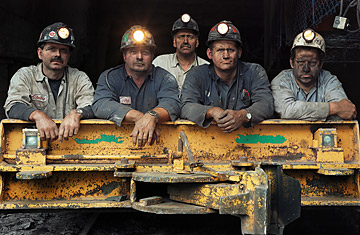
The Powder River Basin in southeastern Montana and northeastern Wyoming can be as beautiful as its name suggests, but that's not why mining companies call it home. The region has one of the richest deposits of coal in the world, enough to yield more than 400 million tons last year--nearly half the coal mined in the U.S. There's enough coal in the Powder River Basin to keep American lights burning for decades, except for one thing--the U.S. is using less and less of the stuff. Thanks to bargain-basement natural gas prices and tougher air-pollution regulations, coal-fired power plants are closing down, and the Energy Information Administration expects coal consumption in the electric-utility sector to drop by 14% this year. That's good news for the environment--coal is a major polluter and contributor to climate change--and bad news for companies that mine coal.
But across the Pacific Ocean, the demand for coal has never been hotter, with China burning 4.1 billion tons in 2010 alone, far more than any other country in the world. That insatiable demand forced China in 2009 to become a net coal importer for the first time, in part because congested rail infrastructure raised the cost of transporting coal from the mines of the country's northwest to its booming southern cities. In April, Chinese coal imports nearly doubled from a year earlier. Right now Australia and Indonesia supply much of China's foreign coal. U.S. coal from the Powder River Basin could be a perfect addition to the Chinese market. Montana and Wyoming are just short train trips to ports on the Pacific Northwest coast, and from there it's a container ship away from Asian megacities where coal doesn't have to compete with cheap natural gas and air-pollution regulations are far weaker than in the U.S. To a wounded Big Coal, China is a potential savior. "We feel U.S. coal is an outstanding product to export to the Asian market as they continue to increase their coal demand," says Vic Svec, a senior vice president at St. Louis--based Peabody Energy, the world's biggest private coal company.
(Not) A Burning Issue
There's just one hitch: right now, ports on the West Coast lack the infrastructure needed to transfer coal from railcars into container ships. (Just 7 million of the 107 million tons of U.S.-exported coal left the country via Pacific Ocean ports last year.) That's why coal companies like Peabody and Ambre Energy are ready to spend millions to build coal-export facilities at a handful of ports in Washington and Oregon. If all those plans go forward, as much as 150 million tons of coal could be exported from the Northwest annually--nearly all of it coming from the Powder River Basin and headed to Asia. Even if the U.S. kept burning less and less coal at home, it would have a reason to keep mining it.
